Vietnamese people
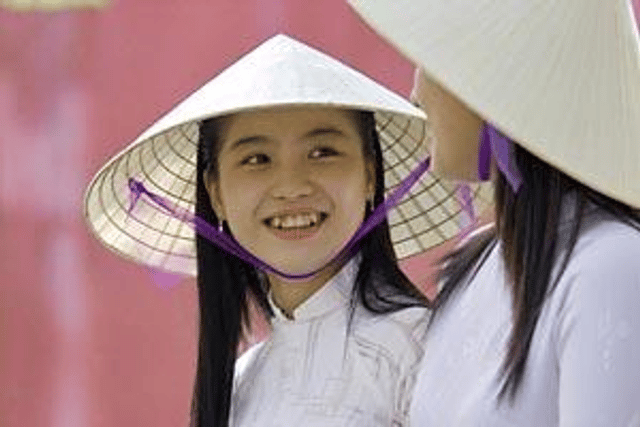
Vietnamese people

| Total population | |
|---|---|
| c.86 million | |
| Regions with significant populations | |
| 2,067,527 (2016)[3] | |
| 750,000–800,000[4][5] | |
| 350,000[6] | |
| 294,798[7] | |
| 262,495 (2017)[8] | |
| 240,514[9] | |
| 200,000 (2014)[10] | |
| 155,553 (2017)[11] | |
| 150,000[12] | |
| 100,000 | |
| 70,000[13] | |
| 28,000 (Vietnam-born, 2014 est.)[14] "At least 55,000" (total, 2007 est.)[15] | |
| 58,080 (2016)[16] | |
| 50,000[17] | |
| 36,225[18] | |
| 36,205[1][19] | |
| 27,600 | |
| 24,465 (2016)[20][21] | |
| 21,721 (2014)[22] | |
| 20,603 (2014)[23] | |
| 17,662 (2010)[24][25] | |
| 14,669 (2014)[26] | |
| 14,496 | |
| 8,000 (2008)[27] | |
| 7,199 (2011)[28] | |
| 7,151 (2001)[26] | |
| 4,875 (2006)[29] | |
| 4,645[30] | |
| 3,850 (2001)[31] | |
| 3,019 (2011)[32] | |
| 3,000[33] | |
| 3,000 | |
| 2,600[17] | |
| 1,000 | |
| Languages | |
| Vietnamese | |
| Religion | |
| Predominantly Vietnamese folk religion syncretized with Mahayana Buddhism. Minorities of Christians (mostly Roman Catholics) and other groups.[34] | |
| Related ethnic groups | |
| Other Vietic groups (Gin, Muong, Chứt, Thổ peoples) | |
The Vietnamese people or the Kinh people (Vietnamese: người Việt or người Kinh), are a Southeast Asian ethnic group native to present-day northern Vietnam, their nation state. They speak Vietnamese, the most widely spoken Austroasiatic language. They comprised 86% of the population of the country at the 1999 census, and are officially known as Kinh (related autonym) to distinguish them from other ethnic groups in Vietnam. The earliest recorded name for the ancient Vietnamese people appears as Lạc.
Although geographically and linguistically labeled as Southeast Asians, long periods of Chinese domination and influence have placed the Vietnamese in the East Asian cultural sphere, or more specifically their immediate northern neighbours, the Southern Han Chinese and other peoples within South China. The word Việt is shortened from Bách Việt, a name used in ancient times for various non-Chinese peoples who were assimilated into Chinese culture. Nam means "south". Together, Vietnam means "to the south of the Viet", as Vietnam is located south of the Bách Việt.
| Total population | |
|---|---|
| c.86 million | |
| Regions with significant populations | |
| 2,067,527 (2016)[3] | |
| 750,000–800,000[4][5] | |
| 350,000[6] | |
| 294,798[7] | |
| 262,495 (2017)[8] | |
| 240,514[9] | |
| 200,000 (2014)[10] | |
| 155,553 (2017)[11] | |
| 150,000[12] | |
| 100,000 | |
| 70,000[13] | |
| 28,000 (Vietnam-born, 2014 est.)[14] "At least 55,000" (total, 2007 est.)[15] | |
| 58,080 (2016)[16] | |
| 50,000[17] | |
| 36,225[18] | |
| 36,205[1][19] | |
| 27,600 | |
| 24,465 (2016)[20][21] | |
| 21,721 (2014)[22] | |
| 20,603 (2014)[23] | |
| 17,662 (2010)[24][25] | |
| 14,669 (2014)[26] | |
| 14,496 | |
| 8,000 (2008)[27] | |
| 7,199 (2011)[28] | |
| 7,151 (2001)[26] | |
| 4,875 (2006)[29] | |
| 4,645[30] | |
| 3,850 (2001)[31] | |
| 3,019 (2011)[32] | |
| 3,000[33] | |
| 3,000 | |
| 2,600[17] | |
| 1,000 | |
| Languages | |
| Vietnamese | |
| Religion | |
| Predominantly Vietnamese folk religion syncretized with Mahayana Buddhism. Minorities of Christians (mostly Roman Catholics) and other groups.[34] | |
| Related ethnic groups | |
| Other Vietic groups (Gin, Muong, Chứt, Thổ peoples) | |
Origins
Written history knows the ancient Vietnamese people first simply as the Lạc or Lạc Việt, and the country of Vietnam as Văn Lang. Archaeological evidence of the Đông Sơn culture (also known as Lac Society) is the result of society from the Bronze Age.
The Vietnamese or Kinh people are an Austroasiatic people and originated somewhere in today southern China.[35] From there, several Austroasiatic tribes migrated to Southeast Asia and parts of today Indonesia and eastern India. The early Vietnamese lived in an area of today northern Vietnam and southeastern China. From there they migrated to other parts of Vietnam. Genetic analysis show that they are a mongoloid population closely related to today southern Chinese and other southeast Asians.[36]
In a 2013 book, professor emeritus of history at UCLA, Damodar R. SarDesai claimed that Vietnamese people were thought for a long time to have come from Tibet, but SarDesai said that more modern hypotheses indicate that the today Vietnamese people are a mixture of northern and southern mongoloid groups. SarDesai said that today Vietnamese are a mix of the Yue(Viet) people and some Austronesian people(see Cham people). SarDesai said that, in around the 3rd century BCE, the Viet people moved into the Red River Delta. He also suggests that Tai-speaking people, arriving from the coastal areas of eastern China absorbed, assimilated and influenced the early Vietnamese people.[37][38]
Anthropometry
Stephen Pheasant (1986), who taught anatomy, biomechanics and ergonomics at the Royal Free Hospital and the University College, London, said that Far Eastern people have proportionately shorter lower limbs than European and black African people. Pheasant said that the proportionately short lower limbs of Far Eastern people is a difference that is most characterized in Japanese people, less characterized in Korean and Chinese people, and least characterized in Vietnamese and Thai people.[39][40]
Nguyen Manh Lien (1998) of the Vietnam Atomic Energy Commission indicated the average sitting height to body height ratios of Vietnamese 17-19 year olds to be 52.59% for males and 52.57% for females.[41]
Neville Moray (2005) indicated that modifications in basic cockpit geometry are required to accommodate Japanese and Vietnamese pilots. Moray said that the Japanese have longer torsos and a higher shoulder point than the Vietnamese, but the Japanese have about similar arm lengths to the Vietnamese, so the control stick would have to be moved 8 cm closer to the pilot for the Japanese and 7 cm closer to the pilot for the Vietnamese. Moray said that, due to having shorter legs than Americans, rudder pedals must be moved closer to the pilot by 10 cm for the Japanese and 12 cm for the Vietnamese.[42]
Craniometry
Ann Kumar (1998) said that Michael Pietrusewsky (1992) said that, in a craniometric study, Borneo, Vietnam, Sulu, Java, and Sulawesi are closer to Japan, in that order, than Mongolian and Chinese populations are close to Japan. In the craniometric study, Michael Pietrusewsky (1992) said that, even though Japanese people cluster with Mongolians, Chinese and Southeast Asians in a larger Asian cluster, Japanese people are more closely aligned with several mainland and island Southeast Asian samples than with Mongolians and Chinese.[43][44]
Hirofumi Matsumura et al. (2001) and Hideo Matsumoto et al. (2009) said that the Japanese and Vietnamese people are regarded to be a mix of Northeast Asians and Southeast Asians who are related to today Austronesian peoples. But the amount of northern genetics is higher in Japanese people compared to Vietnamese who are closer to other Southeast Asians (Thai or Bamar people).[45][46]
A 2009 book about forensic anthropology said that Vietnamese skulls are more gracile and less sexually dimorphic than the skulls of Native Americans.[49]
Matsumura and Hudson (2005) said that a broad comparison of dental traits indicated that modern Vietnamese and other modern Southeast Asians derive from a northern source, supporting the immigration hypothesis, instead of regional continuity hypothesis, as the model for the origins of modern Southeast Asians.[50]
Genetics
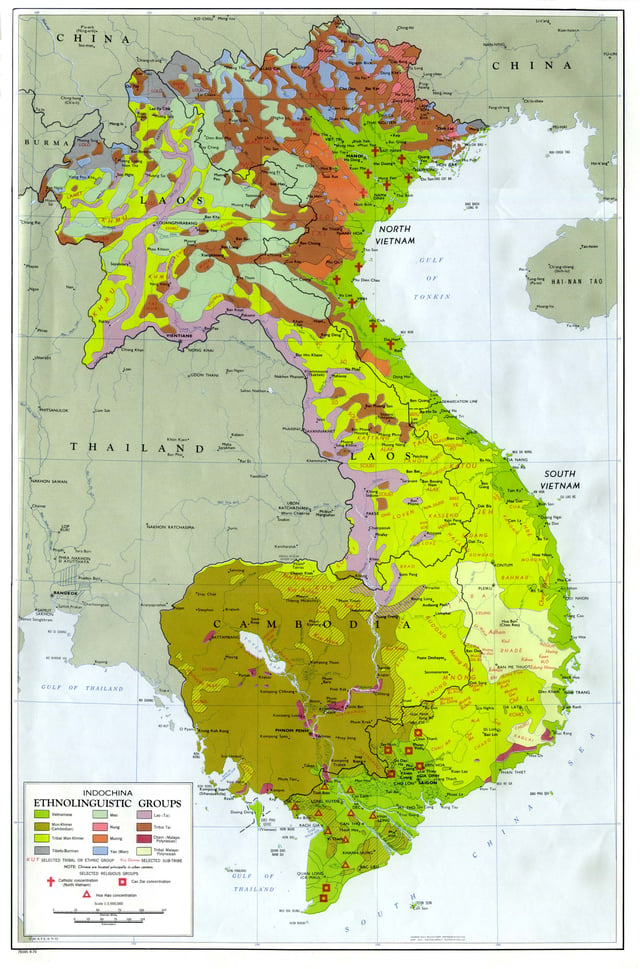
Ethnolinguistic map of Indochina, 1970
Vietnamese show a close genetic relationship with other East Asians with the exception of seven unique markers.[[51]](https://portal.issn.org/resource/ISSN/the original) The reference population for Vietnamese (Kinh) used in the Geno 2.0 Next Generation is 83% Southeast Asia & Oceania, 12% Eastern Asia and 3% Southern Asia.[52]
Jin Han-jun et al. (1999) said that the mtDNA 9‐bp deletion frequencies in the intergenic COII/tRNALys region for Vietnamese (23.2%) and Indonesians (25.0%), which are the two populations constituting Southeast Asians in the study, are relatively high frequencies when compared to the 9-bp deletion frequencies for Mongolians (5.1%), Chinese (14.2%), Japanese (14.3%) and Koreans (15.5%), which are the four populations constituting Northeast Asians in the study. The study said that these 9-bp deletion frequencies are consistent with earlier surveys which showed that 9-bp deletion frequencies increase going from Japan to mainland Asia to the Malay Peninsula, which is supported by the following studies: Horai et al. (1987); Hertzberg et al. (1989); Stoneking & Wilson (1989); Horai (1991); Ballinger et al. (1992); Hanihara et al. (1992); and Chen et al. (1995). The Cavalli-Sforza's chord genetic distance (4D), from Cavalli-Sforza & Bodmer (1971), which is based on the allele frequencies of the intergenic COII/tRNALys region, between Vietnamese and other East Asian populations in the study, from least to greatest, are as follows: Vietnamese to Indonesian (0.0004), Vietnamese to Chinese (0.0135), Vietnamese to Japanese (0.0153), Vietnamese to Korean (0.0265) and Vietnamese to Mongolian (0.0750).[53]
Kim Wook et al. (2000) said that, genetically, Vietnamese people more probably clustered with Northeast Asians of which the study analyzed DNA samples of Chinese, Japanese, Koreans and Mongolians rather than with Southeast Asians of which the study analyzed DNA samples of Indonesians, Filipinos, Thais and Vietnamese. The study said that Vietnamese people were the only population in the study's phylogenetic analysis that did not reflect a sizable genetic difference between Northeast Asian and Southeast Asian populations. The study said that the likely reason for Vietnamese people more probably clustering with Northeast Asians was genetic drift and distinct founder populations. The study said that the alternative reason for Vietnamese people more probably clustering with Northeast Asians is a recent range expansion from South China. The study mentioned that the majority of its Vietnamese DNA samples were from Hanoi which is the closest region to South China.[54]
Schurr & Wallace (2002) said that Vietnamese people display genetic similarities with peoples from Malaysia. The study said that the aboriginal groups from Malaysia, the Orang Asli, are somewhat genetically intermediate between Malaysians and Vietnamese. The study said that mtDNA haplogroup F is present at its highest frequency in Vietnamese and a high frequency of this haplogroup is also present in the Orang Asli, a people with whom Vietnamese have a linguistic connection (Austroasiatic languages).[55]
Jung Jongsun et al. (2010) said that genetic structure analysis found significant admixture in "Vietnamese (or Cambodian) with unknown Southern original settlers." The study said that it used Cambodians and Vietnamese to represent "Southern people," and the study used Cambodia (Khmer) and Vietnam (Kinh) as its populations for "South Asia." The study said that Chinese people are located between Korean and Vietnamese people in the study's genome map. The study also said that Vietnamese people are located between Chinese and Cambodian people in the study's genome map.[56]
He Jun-dong et al. (2012) did a principal component analysis using the NRY haplogroup distribution frequencies of 45 populations, and the second principal component showed a close affinity between Kinh and Vietnamese who were most likely Kinh with populations from mainland southern China because of the high frequency of NRY haplogroup O-M88. The study said that Kinh often have NRY haplogroup O-M7 which is the characteristic Chinese haplogroup. Out of the study's sample of seventy-six Kinh NRY haplogroups, twenty-three haplogroups (30.26%) were O-M88 and eight haplogroups (10.53%) were O-M7. The study said that, in northern Vietnam, it is suggested that there has been considerable Chinese assimilation through immigration into the Kinh people.[57]
A 2015 study revealed that Vietnamese (Kinh) test subjects showed more genetic variants in common with Chinese compared to Japanese.[58]
Sara Pischedda et al. (2017) stated that modern Vietnamese have a major component of their ethnic origin coming from present-day South China and a minor component from a Thai-Indonesian composite. The study said that admixture analysis indicates that Vietnamese Kinh have a major part which is most common in Chinese and two minor parts which have the highest prevalence in the Bidayuh of Malaysia and the Proto-Malay. The study said that multidimensional scaling analysis indicates that Vietnamese Kinh have a closeness to Malaysians, Thai and Chinese, and the study said that Malaysians and Thai are the samples which could be admixed with Chinese in the Vietnamese gene pool. The study said that Vietnamese mtDNA genetic variation matches well with the pattern seen in Southeast Asia, and the study said that most Vietnamese people had mtDNA haplotypes that clustered in clades M7 (20%) and R9’F (27%) which are clades that also dominate maternal lineages in Southeast Asia more generally.[59]
The Vinmec Medical System’s research group has revealed initial results of the Vietnamese genome decoding project (2019). Analysing the Vietnamese genome showed the difference of Kinh people to other populations. The interference and gene transfer from East Asian populations to Vietnamese Kinh population is negligible. About one third of the genetic variation in the Kinh population does not occur in the Han Chinese population and vice versa. The data confirms that Kinh and Thai people have high genome homology in genomes and close evolutionary relationships. It reinforces the scientific hypothesis that people from Africa settled in Southeast Asia and then migrated deep into the continent from the south to the north.[60]
Y-chromosome DNA
Kayser et al. (2006) found four members of O-M95, four members of O-M122(xM134), one member of C-M217, and one member of O-M119 in a sample of ten individuals from Vietnam.[61]
He Jun-dong et al. (2012) found that the NRY haplogroup profile for a sample of 76 Kinh in Hanoi, Vietnam was as follows: twenty-three (30.26%) belonged to O-M88, nine (11.84%) belonged to O-M95*(xM88), nine (11.84%) belonged to C-M217, eight (10.53%) belonged to O-M7, seven (9.21%) belonged to O-M134, seven (9.21%) belonged to O-P200*(xM121, M164, P201, 002611), five (6.58%) belonged to O-P203, two (2.63%) belonged to N-M231, two (2.63%) belonged to O-002611, two (2.63%) belonged to O-P201*(xM7, M134), one (1.32%) belonged to K-P131*(xN-M231, O-P191, Q-P36, R-M207), and one (1.32%) belonged to R-M17.[57]
Having analyzed the Y-DNA of another sample of 24 males from Hanoi, Vietnam, Trejaut et al. (2014) found that six (25.0%) belonged to O-M88, three (12.5%) belonged to O-M7, three (12.5%) belonged to O-M134(xM133), two (8.3%) belonged to O-M95(xM88), two (8.3%) belonged to C-M217, two (8.3%) belonged to N-LLY22g(xM128, M178), one (4.2%) belonged to O-PK4(xM95), one (4.2%) belonged to O-JST002611, one (4.2%) belonged to O-M133, one (4.2%) belonged to O-M159, one (4.2%) belonged to O-M119(xP203, M50), and one (4.2%) belonged to D-M15.[62]
A study published in 2010 reported the following data obtained through analysis of the Y-DNA of a sample from Vietnam (more precisely, Austro-Asiatic speakers from Southern Vietnam according to He Jun-dong et al.): 20.0% (14/70) O-M111, 15.7% (11/70) O-M134, 14.3% (10/70) O-JST002611, 7.1% (5/70) O-M95(xM111), 7.1% (5/70) Q-P36(xM346), 5.7% (4/70) O-M7, 5.7% (4/70) O-P203, 4.3% (3/70) C-M217, 2.9% (2/70) D-M15, 2.9% (2/70) N-LLY22g(xM178, M128), 2.9% (2/70) O-P197*(xJST002611, P201), 2.9% (2/70) O-47z, 1.4% (1/70) J2-M172, 1.4% (1/70) J-M304(xM172), 1.4% (1/70) O-P201(xM7, M134), 1.4% (1/70) O-P31(xM176, M95), 1.4% (1/70) O-M176(x47z), 1.4% (1/70) R-M17.[63]
The individuals who comprise the KHV (Kinh in Ho Chi Minh City, Vietnam) sample of the 1000 Genomes Project have been found to belong to the following Y-DNA haplogroups: 26.1% (12/46) O-M88/M111, 13.0% (6/46) O-M7, 8.7% (4/46) O-JST002611, 8.7% (4/46) O-F444 (= O-M134(xM117)), 8.7% (4/46) O-M133, 6.5% (3/46) O-M95(xM88/M111), 4.3% (2/46) O-P203.1, 4.3% (2/46) O-F2159 (= O-KL2(xJST002611)), 4.3% (2/46) Q-Y529, 2.2% (1/46) O-CTS9996 (= O-K18(xM95)), 2.2% (1/46) O-CTS1754 (= O-M122(xM324)), 2.2% (1/46) O-F4124 (= O-N6 or O-P164(xM134)), 2.2% (1/46) C-F845, 2.2% (1/46) F-Y27277(xM427, M428), 2.2% (1/46) N1b2a-M1811, 2.2% (1/46) N1a2a-M128.[64][65]
Mitochondrial DNA
Schurr & Wallace (2002) displayed the mtDNA haplogroup profile for a sample of 28 Vietnamese as follows: 17.9% belonged to B/B*, 32.1% belonged to F, 32.1% belonged to M and 17.9% belonged to other haplogroups.[55]
He Jun-dong et al. (2012) found that the mtDNA haplogroup profile for a sample of 139 Kinh was as follows: twenty-four (17.27%) belonged to B4, nineteen (13.67%) belonged to B5, one (0.72%) belonged to B6, four (2.88%) belonged to D, twenty-nine (20.86%) belonged to F, one (0.72%) belonged to G, seven (5.04%) belonged to M*, twenty-one (15.11%) belonged to M7, twelve (8.63%) belonged to M8, four (2.88%) belonged to M9a'b, one (0.72%) belonged to M10, two (1.44%) belonged to M12, one (0.72%) belonged to N*, two (1.44%) belonged to N9a, ten (7.19%) belonged to R9 and one (0.72%) belonged to W4.[57]
Sara Pischedda et al. (2017) found that the mtDNA haplogroup profile for a sample of 399 Kinh was as follows: 1% belonged to A, 23% belonged to B, 2% belonged to C, 4% belonged to D, 35% belonged to M (xD,C), 8% belonged to N(xB,R9'F,A) and 27% belonged to R9'F.[59]
Genetic contribution to Koreans
Bhak Jong-hwa, a professor in the biomedical engineering department at the Ulsan National Institute of Science and Technology (UNIST), said that the ancient Vietnamese, which was a population that flourished with rapid agricultural development after 8,000 BC, slowly travelled north to ancient civilizations in the Korean Peninsula and the Russian Far East. Bhak said that Korean people were formed from the admixture of agricultural Southern Mongoloids from Vietnam who went through China, hunter-gatherer Northern Mongoloids in the Korean Peninsula and another group of Southern Mongoloids. Bhak said, "We believe the number of ancient dwellers who migrated north from Vietnam far exceeds the number of those occupying the peninsula," making Koreans inherit more of their DNA from southerners.[66][67]
In later history, there was intermarriage between the aristocracies of Korea and Vietnam, especially with that involving an heir of the Lý Dynasty, Lý Long Tường, who was exiled to Goryeo and who was to become the progenitor of the Hwasan Lee clan that would take root on the Korean peninsula.
Genome sequencing by Vietnamese researchers
Vietnam has a complex history of thousands of years. The fine‐scale genomic analyses of KHV together with other Asian populations elucidated that KHV and other SEA populations mainly derived from the same SEA ancestry. The results from different genomic analyses are generally consistent and support the hypothesis of population migration from Africa to Asia following the South‐to‐North route. Interestingly, they discovered that KHV (Vietnamese from Hanoi) and TAI (Thai from Northern Thailand)[68] populations had similar genomic structures and close evolutionary relationships. The findings suggest the usefulness of KHV database for Vietnamese as well as other closely related populations in Asia.[69]
Legend and early history
According to legend, the first Vietnamese descended from the dragon lord Lạc Long Quân and the female heavenly angel Âu Cơ. They married and had one hundred eggs, from which hatched one hundred children. Their eldest son ruled as the Hùng king.
First Vietnamese
Historians believe that the earliest Vietnamese people gradually moved from the Indonesian archipelago through the Malay Peninsula and Thailand until they settled on the edges of the Red River in the Tonkin Delta. Archaeologists follow a path of stone tools from the Late Pleistocene across Java, Malaysia, Thailand and north to Burma. These stone tools are thought to be the first human tools used in Southeast Asia. Archaeologists believe that at this time the Himalayas, a chain of mountains in northern Burma and China, created an icy barrier which isolated the people of Southeast Asia. During the Last Glacial Maximum (25,000-18,000 BCE), ocean levels dropped significantly. This resulted in the exposure of the shallow areas surrounding the coasts and islands of Southeast Asia - today known as the Sunda Shelf.
It is generally thought that the exposed Sunda Shelf looked like a giant salt plain, and that perhaps people ventured out across this area to settle on other coasts or islands. Later, when the glaciers melted, the Sunda Shelf again disappeared under water. Because it is a relatively shallow body of water, it has always provided a safe area for traders and travelers in small boats to pass safely without the threat of high or choppy seas. In this way, the geography of the area has had a lot to do with the way in which cultures developed. As the map indicates, outside the Sunda Shelf are deep ocean basins which were not often crossed until heavier and wider Chinese vessels (massive vessels from the Song dynasty (960-1279), which dwarfed later European man-of-war sailing ships) could traverse these deep and sometimes dangerous seas.
As the glaciers melted and the seas near these coasts rose, traders and other travelers who wanted to migrate to other areas, or perhaps to proselytize religion, used boats as transport. For the next 4,000 years, until 8000 BCE, people also moved across the mainland of Southeast Asia towards the Tonkin Delta, some stopping and settling along the way. Eventually, the descendants of these migratory peoples entered the Neolithic Age (from around 8000-800 BCE), when humans started to use simple stone tools. Remains of these people and the Hoabinhian culture have been found in the Hòa Bình Caves along the Red River and in the Tonkin Delta. In the Middle Neolithic Period (2500–2000 BCE), more people appeared in the area of present-day Vietnam and settled at another location called Bắc Sơn, in a central area of the Tonkin Delta. These people were probably somewhat taller and lighter-skinned than the Hoabinhian negritos; they excelled in the art of basket weaving as well as in the manufacturing and use of polished double-edged stone tools.
Earlier Vietnamese groups
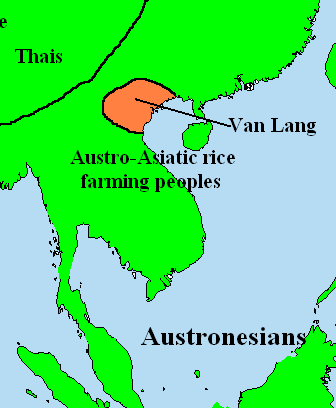
Map of Văn Lang, 500 BC.
Sometime after the advent of the societies found at Hòa Bình and Bắc Sơn, another group of people developed a culture in what is modern Nghệ An Province, where an aspect of their religion was manifested in large mounds of mollusk shells which had been collected from the Red River Delta. Bodies had been buried under these piles of shells in a seated position with bent knees - in the same position as many buried bodies found throughout Indonesia and the Philippines. This signifies to archaeologists that these early people had an advanced society based on fishing and that their religion was oriented toward the sea. At a location further south of the Tonkin Delta, in the central region of Vietnam's coast, remains of another culture have been found at Sa Huỳnh. The Sa Huỳnh culture existed from about 4000 to 1000 BCE. Tools, ornamental beads, and funerary jars have also been found at these archaeological sites. These jars were usually located at the water's edge and probably signified a dead person's journey out to sea.
Throughout Southeast Asia, the Neolithic Period can be considered the period in which organized societies developed. During this period the Vietnamese people spread across a large area from the foothills of the Annamite Range to the eastern coast of Northern Vietnam. It is thought that they lived in small communities with groups of extended families living in a simple communal way. The growing of rice, their staple food, had developed into two distinct methods, shifting cultivation, done on a dry field, usually in upland areas, and wet rice cultivation, which involved the construction of dikes around rivers that collected water into knee-deep ponds in which the rice was grown.
Cultural and historical influences
North
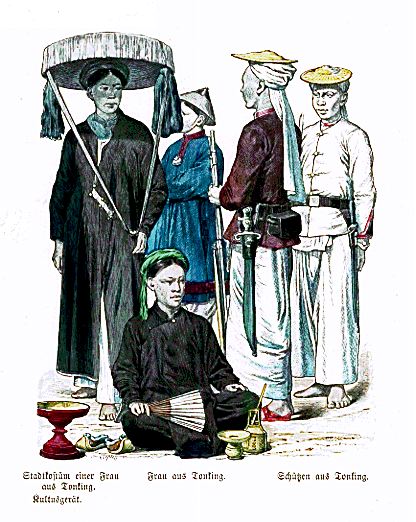
People of Tonkin, 1861-1880
Before the Chinese actually annexed Vietnam, groups from present-day southern China began to move into the Tonkin Delta in order to start new lives after being forced to leave their homelands. Thus, around the 3rd century BC, changes in China began to heavily influence the Đông Sơn culture which was thriving in Vietnam. One important series of changes occurred along the Yangtze River in southern China. According to historians, in 333 BC, three cultures, the Shu, the Ch'u, and the Yueh began to fight among themselves, causing the Yueh to move south in small scattered kingdoms. At the same time, the central power of northern China, the Ch'in Dynasty, began to split so that a large number of princes and members of the aristocracy also moved south to start their own small kingdoms. Sino-Vietnamese 越 gave the name "Viet".
The people of the Red River civilizations, also known as Lac society, began to feel the effects of these newcomers who gradually moved into their homelands. Many historians believe that it was not difficult for the Yueh to be incorporated into Lac society. However, the Au Lac lords began to fight with the Ch'in princes. While they were involved in this fighting, another group from the northwest, the Thuc (who had once been the Shu of the Yangtze River) took advantage of weakness in the area and asserted their authority. The legendary Cổ Loa Citadel, the remains of which can still be seen today. An Dương Vương's arrival explains the origins of the legendary Âu Lạc kingdom which is usually associated with the height of Đông Sơn culture. Vietnamese language may be representative of these influences.
South
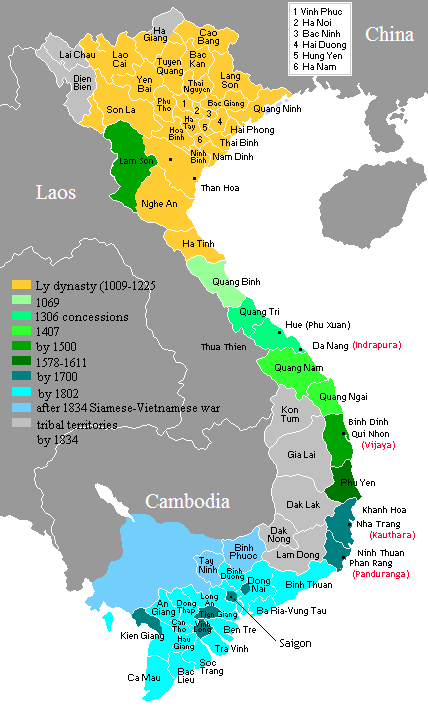
Map of Vietnam showing the conquest of the south (the Nam tiến, 1069–1757).
Vietnam today is characterized by two major river deltas, the Red River Delta in the north and the Mekong Delta in the south. In prehistoric times, before the ethnic Vietnamese moved southward, another Indianized kingdom formed along the coasts north of the Mekong Delta. It was composed of Malayo-Polynesian people and was highly influenced by Indian and Indonesian traders and religious people. This area developed into the kingdom of Champa which was similar to other Hindu-Buddhist civilizations which were being formed in Indonesia, Burma, Thailand, and Cambodia.
Champa did not become an established kingdom until 192 AD after which time it became quite advanced with walled cities, books and archives, palaces, and monuments, many of which were built by slaves. Residents of Champa were able to grow two crops of rice per year with a sophisticated system of irrigation which was overseen by a water chief, someone selected to monitor the irrigation ditches and canals. While some cities in Champa remained centers of religion and trade, this kingdom was mostly made up of small territories in river valleys and on coastal plains, each with a local ruler who was seen by his subjects as a representative of the gods. The height of Cham civilization occurred during the 6th to 8th centuries. At this time, much trading occurred between the Chams and the highlanders who needed salt as well as with coastal villages in Vietnam and with China. Important trade items included elephant and rhinoceros tusks, cardamom, bee wax, aromatic woods and betel nut. However, when times were not going well in the small coastal city-states, the people turned to looting and pirating in other coastal towns of Champa and Vietnam. After centuries of these pirate raids, the Vietnamese began to fight back and eventually conquered Champa, but not before many aspects of Cham society were incorporated into the societies of Vietnam Cham society is organized in a cluster of City-States, not very different from ancient Greece, in contrast of centralized Vietnamese society influenced by China in the north.
Prehistoric mythology

Percentage of Vietnamese people, by province (2009)[71] <20% 20%-40% 40%-60% 60%-80% 80%-95% >95%

Rickshaw in Hanoi in the 19th century
The movement and changing cultures of early Vietnam are explained through myths which give historians insight into what might have happened in the Dong Son era. The most well-known origin myth says the first Vietnamese people originated from the marriage of a dragon father and a fairy mother who had 100 sons. Because the dragon was a water creature and the fairy was a land creature, they decided they could no longer stay together. The fairy mother took 50 sons to the highlands, and the dragon father took 50 sons to the coast. One of the sons who went with the dragon father became the founder of the Hung Dynasty which is thought to have existed from as early as 2769 BC until 100 AD. The 50 sons who went to the coast are considered to be the people of the Lac Kingdom. According to historians and archaeologists, the Lac people were coastal people who had developed a sophisticated wet rice agricultural society from as early as 1500 BC. The Hungs, as depicted in the mythology, were mountain people who are believed to have had a reciprocal agreement with the Lac Kingdom so that the Hungs protected the Lacs from aggressive mountain groups in return for rice and other crops grown on the coastal plains of the Red River. These mythological stories, which in many cases can be matched with archaeological remains, tell of the joining of fire and water, or the earth people and the water people. The joining of these two elements has both historical and religious meaning.[70]
Many historians believe that the original people of Vietnam came both overland and across the water bringing different cultures, languages, and types of people together in the Tonkin Delta. Some historians believe that the water god of the Dong Son people was the frog, which might explain the many frogs found on the Dong Son drums and might indicate that the first Dong Son people arrived in Vietnam by sea. Later this symbol was changed to the dragon following Chinese mythology. These origin myths were not written down by the Vietnamese people until about the 13th century AD, long after the Vietnamese had been colonized by the Chinese.[72]
Origin myths also show how the early Vietnamese people saw themselves in terms of their environment. Since water and sun were the most important elements of nature, they were incorporated into their mythology in a way which gave the people and the elements a common origin. Much of early Vietnamese religion involved nature and human relationships with their surroundings. The early Vietnamese people compared the soil, the water, and the sun to God in animism. In these elements there was energy which benefited the people and the greater power to help or to destroy. At times this power was compared to that of a child who may cause great destruction without even realizing it. In the earliest times people believed in ghosts and spirits which were thought to dwell in every tree, stone, mountain, cloud, stream, and animal. Rocks and mountains were thought to be able to multiply. These spirits were said to be the wandering souls of the dead, the ancestors of the people who had settled nearby. This type of religion is known as an ancestor cult. Because the ancestor spirits were the medium between living people and the greater forces of nature, they had to be honored in rituals and sacrifices in order to maintain harmony between the elements, the spirits, the ancestors, and the people. Later, as the Vietnamese people were converted to Buddhism, Taoism, and then Confucianism by the Chinese, most villagers maintained these original beliefs—especially those involving ancestor cult and incorporated them into the new religions. This is an example of "creative borrowing" by a people while their own culture remains a strong underlying force.[73]
Early historical period
Chinese histories refer to the early inhabitants of southern China and northern Vietnam as the Baiyue, also shortened to Yuè,[74] which is cognate to Vietnamese Việt. In 258 BCE An Dương Vương founded the kingdom of Âu Lạc in the area of present-day northern Vietnam. In 208 BC, Zhao Tuo, a former Qin dynasty general from China, allied with the leaders of the Yue in the area of modern-day Guangdong and declared himself king of the Nanyue "Southern Yue". He defeated An Dương Vương and combined Âu Lạc with his territories in southern China.
Diaspora
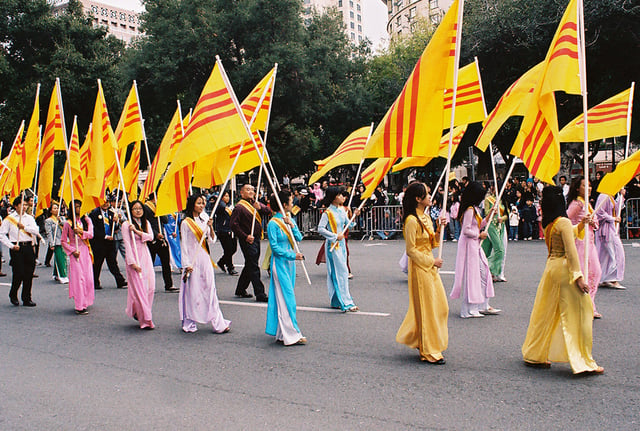
Vietnamese New Year parade, San Jose, California.
Originally from northern Vietnam and southern China, the Vietnamese have conquered much of the land belonging to the former Champa Kingdom and Khmer Empire over the centuries. They are the dominant ethnic group in most provinces of Vietnam, and constitute a significant portion of the population of Cambodia.
Beginning around the sixteenth century, groups of Vietnamese migrated to Cambodia and China for commerce and political purposes. Descendants of Vietnamese migrants in China form the Gin ethnic group in the country and primarily reside in and around Guangxi Province. Vietnamese form the largest ethnic minority group in Cambodia, at 5% of the population.[75] Under the Khmer Rouge, they were heavily persecuted and survivors of the regime largely fled to Vietnam.
During French colonialism, Vietnam was regarded as the most important colony in Asia by the French colonial powers, and the Vietnamese had a higher social standing than other ethnic groups in French Indochina.[76] As a result, educated Vietnamese were often trained to be placed in colonial government positions in the other Asian French colonies of Laos and Cambodia rather than locals of the respective colonies. There was also a significant representation of Vietnamese students in France during this period, primarily consisting of members of the elite class. A large number of Vietnamese also migrated to France as workers, especially during World War I and World War II, when France recruited soldiers and locals of its colonies to help with war efforts in Metropolitan France. The wave of migrants to France during World War I formed the first major presence of Vietnamese people in France and the Western world.[77]
When Vietnam gained its independence from France in 1954, a number of Vietnamese loyal to the colonial government also migrated to France. During the partition of Vietnam into North and South, a number of South Vietnamese students also arrived to study in France, along with individuals involved in commerce for trade with France, which was a principal economic partner with South Vietnam.[77]
Forced repatriation in 1970 and deaths during the Khmer Rouge era reduced the Vietnamese population in Cambodia from between 250,000 and 300,000 in 1969 to a reported 56,000 in 1984.[78]
The Fall of Saigon and end of the Vietnam War prompted the start of the Vietnamese diaspora, which saw millions of Vietnamese fleeing the country from the new communist regime. Recognizing an international humanitarian crisis, many countries accepted Vietnamese refugees, primarily the United States, France, Australia and Canada.[79] Meanwhile, under the new communist regime, tens of thousands of Vietnamese were sent to work or study in Eastern Bloc counties of Central and Eastern Europe as development aid to the Vietnamese government and for migrants to acquire skills that were to be brought home to help with development.[80] However, after the fall of the Berlin Wall, a vast majority of these overseas Vietnamese decided to remain in their host nations.